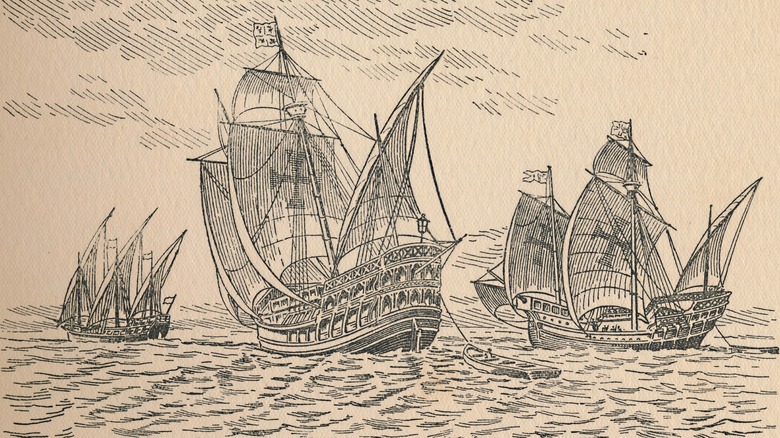What Were The Real Names Of Christopher Columbus' Ships?
Much of the narrative you were taught about Italian explorer Christopher Columbus is patently false. For example, Columbus didn't "discover" America any more than Neil Armstrong "discovered" the Moon. He didn't land anywhere near the landmass that would eventually be called the United States of America, and almost certainly wasn't even the first European there (that would be Leif Erickson). Further still, Columbus didn't sail west intending to find a faster route to the spice-rich Far East, in defiance of fears that he'd fall off the edge of the (flat) Earth. It had been known for centuries that the Earth was round.
Another myth about Columbus that has persisted over the centuries comes from the names of his ships. Historically, schoolchildren have been taught that he and his crew sailed on the Niña, the Pinta, and the Santa Maria. However, history records that at least two of those ships had different official names, and that the names we've been calling them were actually the sailors' nicknames for the vessels.
La Niña was actually Santa Clara
According to the Columbus Foundation, in Columbus' day it wasn't unusual for ships to be given the name of a female saint. One of the ships to sail on Columbus' first voyage was officially called "Santa Clara," after the patron saint of the Spanish port city of Moguer. The ship's owner was Juan Niño of Moguer, and the Columbus Foundation posits that the ship's nickname was simply a feminized version of its owner's name: "Niño" is Spanish for "little boy" and "niña" the word for "little girl."
The niña was Columbus' favorite of the three ships to make his initial 1492 voyage, and indeed, his favorite ship he ever sailed on, according to the foundation bearing his name. The vessel continued to sail for another decade, surviving at least one hurricane and one takeover by pirates. She is believed to have sailed at least 25,000 miles on Columbian voyages alone.
The Santa Maria's naming story is complicated
Two sources give three similar yet competing versions of the relationship between the real name of Columbus' ship, the Santa Maria, and its nickname. For example, History claims that "Santa Maria" was the vessel's actual name, but that it also had a nickname, "La Gallega," or "the Galician," referring to someone from the Spanish province of Galicia. Christian Science Monitor, however, claims that the ship was originally La Gallega, but that, in keeping with the "tradition" of sailors sometimes naming ships after their favorite sex workers, it became "Santa Maria" ("Saint Mary" or "Holy Mary," depending on context) after a sex worker, Maria Galante. "Maria Galante" could refer to her actual name, or it could be something akin to "Brave Mary."
The matter of the disconnect between the two possible names of the Santa Maria (La Gallega) is explored in greater detail in an abstract, "The journal of Christopher Columbus (during his first voyage, 1492-93) and documents relating to the voyages of John Cabot and Gaspar Corte Real," available via The Internet Archive.
The pinta probably referred to a sex worker
We don't know, for certain, the actual name of the third ship that Columbus and his crew sailed to the New World, but it almost certainly wasn't "Pinta." As previously mentioned, custom of the day dictated that a ship would be named for a saint, and there is no saint with a name even adjacent to the word "Pinta." One possibility is that it could have been owned by a man named Pinto, except, as Life Persona notes, its owner's name was Quintero.
The Spanish word "pinta" means something not unlike "the marked one" or "the spotted one," and comes from the same root word that gives us "la pintada," or "the painted one," says Christian Science Monitor. Life Persona suggests that the vessel could have been painted in bright colors, but most likely, the ship's name comes from a word used to refer to a sex worker. Specifically, "pintada/painted one" could refer to the heavy makeup that a sex worker would have worn.



